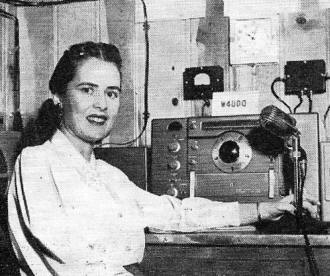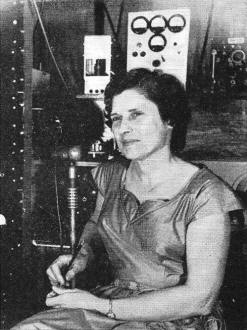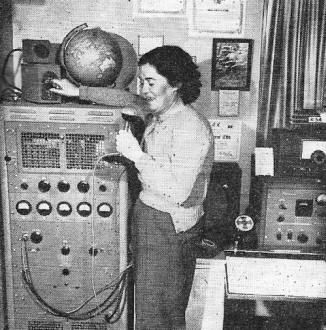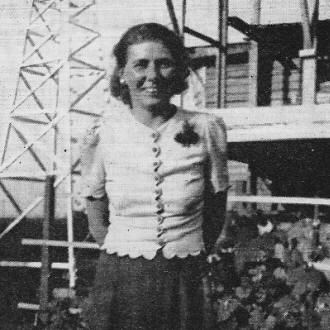YL News and Views |
|
I wonder why today's editions of the ARRL's QST magazine does not have a column dedicated to the "YL" (Young Lady, or female in general*) contingent of the amateur radio realm? Ham radio, as most - if not all - historically male-dominated hobbies has fairly significant outreach efforts to try attracting women into activities. My Model Aviation magazine has a monthly column written by a lady whose enthusiasm for model airplanes equals that of most males - and she's funny to boot! - but it is not dedicated to female modelers. If there is a girl or woman present at a competition, she is almost guaranteed to receive coverage in the form of a photograph and/or mention in an article. Any lack of other-than-male participation these days can only be attributed to a lesser degree of interest by other than males. Could there really be a difference between men and women (in general) after all? * Website visitor Ed W. wrote to remind me that "XYL," i.e., ex-YL or ex-young-lady is often used for a married female Ham. The term is considered less than complimentary by some who say the "ex-" prefix connotes no longer being young and/or no longer being a lady. XYL has been around for a long time (including being used in this c1953 article), so maybe it's primarily the newer, easily offended YL's who discourage the "X" prefix. If you want to be safe, use "YL" to generically refer to any female amateur radio operator. Come to think of it, these day the label of "YL," originally adopted as a complimentary reference, is probably offensive to some who disparage the application of any gender-specific designations. Oh well, you can't please everybody. "YL News and Views" Articles in QST magazine April 1953 | October 1953 | November 1953 | December 1953 | July 1966 | October 1966 YL News and Views
Can We Interest You? While preparing a little "sales talk" in the hope of interesting more YLs in working the very high frequencies, the thought occurred that it would be best to let some of the YLs well known in v.h.f. circles try to "sell" the idea themselves. Margaret Roberts, W8BFQ, winner of nine section awards in ten v.h.f. contests entered (national high scorer in the June, '52, affair), who has worked 41 states on Six and 21 states on Two, and who broke the world's 220-Mc. record last September by working W1HDQ (record since broken), seemed to sum up in one letter most of the thoughts of all of the girls contacted for the project, so we'll let Margaret do the first" commercial": W4UDQ uses an SCR-522 at 15 watts, a crystal-controlled converter into an HRO and a "5-over-5" Yagi on 144 Mc. On 220 Mc. Dorothy has an 832 running at 20 watts, a 6J6 r.f. HFS-HRO receiving combination and a 32-element array. W8BFQ operates 50, 144, 200, 420, 1215 and 2400 Mc. with inputs of 300, 800, 300, 50, 80 and 0.5 watts respectively. Margaret has worked seven states on 144.Mc. radioteletype and has earned DXCC, WAC and WAS on 28 Mc. W8FMW runs 250 watts to a home-built 2-meter transmitter and receives with a crystal-controlled converter ahead of a Super Pro. Ann's antenna is a 32-element array. W2FHJ has separate 829B rigs on Two and Six, 50 and 90 watts respectively. Viola uses a 6-element beam on 144 Mc. and a 4-element affair on 50 Mc. The 2-meter equipment at W9DXX includes an SCR-522 transmitter, an AR-88 with VHF-152A converter and a 5-element Yagi skywire. Alice also has worked her share of DX on the lower frequencies. Remember 'way back, when everything "from 200 meters and down" was amateur territory? Well, perhaps it's very hard to sell an article until it's scarce, but I do hope you can help sell "v.h.f. while there is plenty to go 'round. As for my story, all I can claim is enthusiasm, with maybe a little persistence [A little? - Ed.] thrown in. I'm neither a good rag-chewer nor an experimenter, and I have no scientific, interest in radio, but I do have fun on v.h.f. I had fun on the lower frequencies also, but there's something about the very-highs - the friendly contacts, the exciting unpredictability, the freedom from QRM, the challenging ARRL v.h.f. contests. I've found the v.h.f, gang in general the most enthusiastic of all hams, and the good-fellowship among them almost unbelievable. The v.h.f. contests furnish a lot of competition, but a lot more cooperation. Six-meter F-layer openings provided DX hunting as thrilling as any lower-frequency DX; sporadic-E openings were as exciting, and by reporting these openings to the Air Force through RASO I felt I was helping in a small way in the amateur tradition. I've watched the working ground-wave range on two meters grow, stayed up all night during tropospheric openings, strained my ears over weak signals and raised my blood pressure to the danger point when "impossible" signals were arriving by auroral reflection. Working W1HDQ for the 220-Mc. DX record was a greater thrill than my rarest DX on lower frequencies; and when W2QED's 420-Mc. signal came over the Alleghenies and he couldn't hear mine, I felt worse than if I'd missed AC4YN. And so Margaret could go on and easily write several articles of her own filled with her experiences and reasons why she has been sold on v.h.f. Thoughts expressed in other letters received reinforce what Margaret has already said or implied. Well-known W9DXX, Alice R. Bourke, who has worked some 325 different stations on two meters, writes that she likes v.h.f. "because of the high concentration of fine, friendly people who populate those frequencies." WN9RUJ, Mary Meyer, a newcomer to v.h.f., is happy about the warm welcome the v.h.f. gang gives to new stations. W4UDQ, Dorothy B. Wilson, knows that it's still possible to get excited over working a station only 75 miles away - if you're on 220 Mc.! W8FMW, Ann Hughes, sums up the challenging surprise element in v.h.f. when she says that "you never know just what you are going to be able to do. Like fishing, you never know what you're going to hook. There is something about it (two meters) that you can't give up after you once get acquainted with the band." Intrigued with the higher frequencies since 1933, W2FHJ, Viola Kapp, finds that "it is looking forward to the unexpected and freak conditions which holds the interest of the v.h.f. 'diehards'." Although Viola has worked 44 states on Six and 13 on Two and has regularly won v.h.f. contest awards, she uses low power and crystal control, using only one frequency on either two or six meters, thus proving what a simple, efficient rig along with a measure of stick-to-it-iveness can do on the higher frequencies. And Marvel Sines, W8HUX, writes that she "has worked twelve states and many stations in Canada on Two. Of course, to those not having experience with v.h.f. that would not sound like very many. But when we work a new state on v.h.f. it is as much of a thrill as working a new country on some of the other bands. I wish more YLs and XYLs would get on ... " Yes - we do too, Marvel. Sounds as if there's room, fun, and new experiences for all. See you in "the world above 50 Mc.!" Keeping Up with the Girls There are now some thirty ZS6 YLs ... W3CDQ, Liz, has been Asst. Atlantic Division Director for better than twelve years ... Ex-W0CCK is now W5YRT. Maxine writes that there is one other YL at her new QTH (Tyler, Texas) and that her name is Maxine also (W5VSN) ... W3AKB, Fran, and W3MSU, Ethel, are members of the Washington chapter of the newly formed Society of Women Engineers .... OM W0GMZ calls attention to the fact that the early call of the late May Smith was 1BAE and not prefixed by a "W" as given in the Jan., '53, column. ... W9MGT, Lenore, reports more new very young YLs in her radio classes at the Browning School, Granville, Wisconsin (see Nov., '52, column) - WN9s UCU, VAE and VCM, all age 9, and WN9VAP, age 14 ... And 14-year-old W1WDX, Nancy, proudly reports that her 9-year-old sister Helen is WN1WYT ... VE8PF, Mary, of Whitehorse in the Yukon Territory, enjoyed a visit with KL7CY, Flo, at Anchorage, Alaska ... W4ITR is at present living in Baguio City in the Philippines. Ida, who worked 123 countries when in the States, is unhappy about a new ruling there which prohibits amateur operation by "aliens" ... WN4WXF, Clara, is an enthusiastic new Novice from Antioch, Tenn ... New officers of the Long Island Unit of YLRL are Pres. W2KDP; V. P. W2BXT; Sec.-Treas. W2JZX; Board, W2s KEB and GRQ ... The day after OM WN2IQW worked his first YL, WN3-URU, Sara, of Norristown, Pa., Doc answered a CQ put out by WN3URT, June, who turned out to be Sara's twin sister! ... W8GJX's (Helen Cloutier, Escanaba, Mich.) new novel Sim Barton, Girl Radio Operator, has recently been released. The story of a girl's determination to achieve success as a commercial radio operator on a Great Lakes' ship, the book should be of interest to young girls who aspire to be radio operators. Miscellany The LARK (Ladies Amateur Radio Klub) of Chicago announces that a certificate will be awarded to any amateur who works ten LARK members. Send members' calls and dates and frequencies of the QSOs to Gladys, W9MYC. The LARK now meet at 1400 CST on Wednesday (10 meters) each week, except the first week of the month when they meet at 2200 CST on Tuesday. April eleventh is the date of the semi-annual W1 YL Luncheon (YLRL members and nonmembers alike). The place is the Smith House in Cambridge, Massachusetts. Write Helen Wright, W1UPZ, P. O. Box 126, Brookline 46, Mass., for further information. Wava Harlan, W8FPT, is the YLRL District Chairman of the eighth call area. First licensed in 1950, Wava is active on 10, 20 and 75. Her OM is W8EAM. Since the start of her term last July, Wava regularly has sent postcards to each of the licensed YLs in her district, in quest of information and news. Other DCs who follow this practice find it's worth the little extra time and effort. * YL Editor, QST.
Posted March 2, 2023 |
|

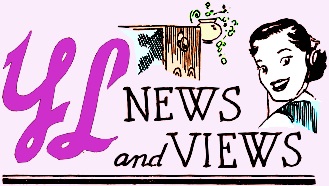 By Eleanor Wilson,* W1QON
By Eleanor Wilson,* W1QON 